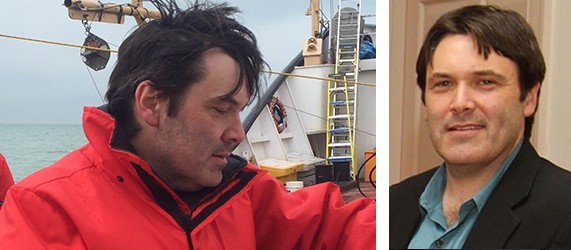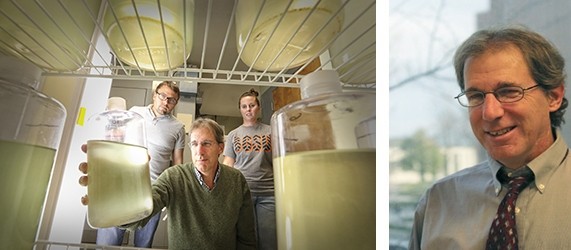Life under ice: Lake Erie’s "other" algal bloom
Ice cover presents a logistical obstacle to our understanding of north temperate ecosystems. Reflecting this, ecosystem models frequently underestimate, or even neglect biological parameters associated with ice cover including potentially high rates of primary productivity. Yet current warming trends in global climate are reinforcing the need to focus attention on ice covered environments. Addressing this void in our understanding, annual field surveys of Lake Erie have been conducted since 2007 with the majority of these campaigns coinciding with high lake wide maximum ice coverage surpassing 80%.
Despite the perceived inhospitable environment imposed by cold temperatures and ice cover during winter in Lake Erie, these surveys have revealed numerous examples of high biological activity. Foremost among these observations, high winter phytoplankton biomass in the Lake which is often in discrete formations located under the ice and dominated by psychrophilic, filamentous centric diatoms. Further, it appears that diatom assemblages possess ice-nucleating abilities, a characteristic that promotes their association with ice cover allowing them to maintain a favorable position in the photic zone in the absence of wind-aided turbulence. The diatoms are physiologically robust and the diatom bloom persists through early spring.
While we are growing more confident in our predictions of factors that will lead to bloom development, identifying factors that lead to bloom decline and the subsequent fate of this biomass remain important questions to address. While nutrient depletion and ice melt are undeniably factors that contribute to the decline of Lake Erie’s winter bloom, recent surveys point to novel interactions with microbial pathogens as important to bloom decline.
Professor Mike McKay joined the faculty of Bowling Green State University in 1997. Mike received undergraduate- and graduate degrees from Queen’s University at Kingston and McGill University (Montréal), respectively. Following his PhD, he held postdoctoral fellowships at the University of Alaska Fairbanks and at Brookhaven National Laboratory. There, Mike became active in research on iron biogeochemistry through his involvement with ecosystem-scale ocean iron fertilization projects. At BGSU, Mike’s research has expanded to include large lakes where he studies nutrient cycling, phytoplankton and bacterial community dynamics and more recently, winter limnology involving research coordination with Coast Guard icebreaking programs.
Planktothrix and Microcystis cyanobacterial blooms: the toxic twins of Lake Erie
George S. Bullerjahn, Professor of Research Excellence, Bowling Green State University
Whereas much attention has been devoted to studying the Microcystis harmful algal bloom (HAB) events in the lower Laurentian Great Lakes, tributary sites are often affected by persistent blooms of Planktothrix, a filamentous microcystin-producing cyanobacterium. Our labs are examining the factors that allow these organisms to occupy different ecological niches.
Regarding Planktothrix, HABs are typically of longer duration (May-October), routinely yielding microcystin levels in excess of 20 ppb. In agreement with prior studies on the Planktothrix bloom in Grand Lake St. Marys (OH), Sandusky Bay midsummer dissolved inorganic N concentrations often fall below detection, and bottle assays indicate that enhancement of summertime bloom conditions is often dependent on N additions, rather than P. Losses of N in Sandusky Bay are attributed in part to high rates of denitrification in the sediments. We hypothesize that N availability is a major driver of Planktothrix dominance in the Bay, distinct from open water Microcystis HABs in which P is traditionally viewed as the key factor for biomass production. Indeed, work in other labs has shown that Microcystis is an effective scavenger for P.
The success of Planktothrix in an N-limited system is notable given that this genus is not an N fixer, but metatranscriptomic analyses reveal a minor cyanobacterial community of N fixers contributing new N into the system. Analysis of Sandusky Bay blooms by qPCR and 16S iTags also reveals that Planktothrix presence and abundance is correlated with N speciation.
Professor George Bullerjahn has been a faculty member at Bowling Green State University since 1988. He earned his undergraduate degree at Dartmouth College, and received his PhD at the University of Virginia. He initially worked on the physiology of cyanobacterial responses to oxidative and nutrient stress, followed by studies on growth of toxic bloom-forming taxa. His lab’s work is currently focused on the composition and dynamics of cyanobacterial and nitrifying communities in freshwater environments, focusing primarily on their roles in the N and P cycles in the Laurentian Great Lakes. These studies assist in the assessment of factors contributing to toxic cyanobacterial bloom events in freshwaters.

